Temples, Gardens and Shrines: Kyoto 2-5.11.2002
Ask anyone for hints where to go in Japan and you'll probably get
an answer "Don't miss Kyoto". To get an idea, my 793 page guidebook
"Gateway to Japan" dedicates a whopping 104 pages to this city alone.
Kyoto (京都) was the capital of Japan for many centuries until the end
of the 16th, both in means of power and cultural activities. It also
escaped most of destructive bombing during the second world war so a
good number of the landmarks of ancient rulers have survived. Buddhist
temples used to be centers of both religious and military power.
Monday and Tuesday after the first weekend in November were
vacation from the university so it was a good opportunity for a short
trip outside Kanazawa. I had planned to take an early morning bus on
Saturday, but unfortunately they were all full-booked about one week
in advance. I didn't want to pay double the price for a train and
opted for the afternoon bus paying a reasonable 6600 yen round-trip
fare. After a 4 hour ride I arrived in Kyoto around 7 o'clock Saturday
evening.
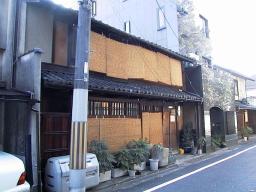
|
I stayed in a youth hostel called Uno
House. For 1650 yen per night you get an about 80x270 cm slice of
floorspace in one of the dormitory rooms - just enough to roll the
futon on the tatami, put your backpack against the wall and still
leave a passage free so that others can reach their own place without
stepping on you. You also get the authentic experience of sleeping in
a Japanese style house with wood and paper walls.
|
The hostel had many wonderful peculiarities. One of my favourites was
a coin-operated (100 yen) air conditioner in the living room which is
in common use of all the guests. In November we were more interested
about the heaters which were cleverly equipped with timers to avoid
wasting petrol at night - and to make sure that guests remembered to
use their blankets...
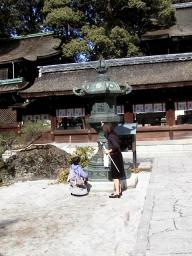
|
After Kinkakuji we went to Imamiya shrine (今宮神社) and were lucky to
get in the middle of Shichi-go-san matsuri. It's an event where
parents dress their seven, five and three year old children in their
best kimonos and bring them to visit a shrine. We had great fun
watching this mother trying to get her boy stay still long enough for
taking a photo - the kid clearly was much more interested to run
around and explore the place.
|
By the way, a shrine (神社 - "jinja" in Japanese) refers to Shintoism
and temple (寺 - "tera" or "ji" in Japanese) to Buddhism. These two
religions coexist peacefully in Japan and most people actually belong
to both of them. Buddhism could perhaps be characterized as more
serious and uniform of the two (although there are several different
"sects" of Buddhism) while Shinto is tied to the local culture of each
area and has many lively and colourful celebrations. However, the
Japanese tend to have a quite flexible approach to both and don't mind
foreigners coming to see and participate in the customs.

|
Zen is one of the major sects (styles) of Buddhism. It emphasizes
simplicity and meditation and this is reflected in the architecture as
well. Zen temples are less vividly decorated than others, gardens
usually consist mostly of rocks and sand. Here you can see a river
flowing into the sea and a ship floating peacefully in the bay.
|
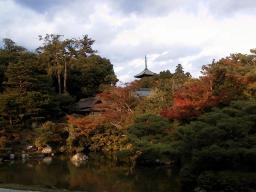
|
It was a bit early but in a few places trees had already dressed
in their best autumn colors. This is from Ninna-ji temple (仁和寺).
|

|
Japan is full of "convenience stores" and other small shops which are
open seven days a week around the clock or at least very late in the
evening. But this bookstore must be especially designed for busy
people because it's open until 26.00! Me too, I want two extra hours
in my day! :-)
|

|
The dinner in a popular restaurant near the hostel offered the next
surprise. Slavka is a vegetarian and Japanese restaurants don't tend
to have too good selection of plates without any meat or seafood.
Here she ordered a small but tasty-looking salad which came with a
"gift" of three potatoes in a plastic bag. Yes, uncooked potatoes! We
kept joking for a while if we should ask the personnel to bring us a
cooker so we could boil them at the table, but eventually didn't.
|

|
We had seen a fair number of temples, shrines and gardens but went
still to see Shorenin temple (書蓮院) because it was open
until late with special illumination on that day. That was a great
decision: busloads of tourists hadn't find the place and there weren't
any loudspeaker-equipped guides either. Instead there were mostly
Japanese people who had come there to hear a short speech by one of
the monks and then leasurely stroll around the nicely illuminated
garden.
|
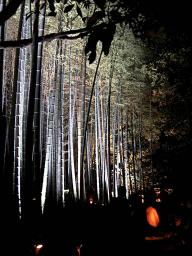
|
The bamboo forest reflecting light back in silver was my favourite.
|
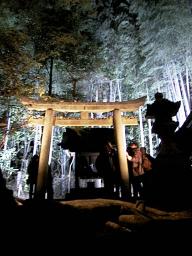
|
There was a small shrine too (in the photo) and a special light setup
on the lawn in front of the temple. Most of the time it consisted of
circles and once in a while briefly formed a character of ancient
Buddhist writing in the middle. One Japanese person explained the
symbolism to us - I missed most of it but one belief was that when the
character appears one should wish something and it'll become true. The
tour ended at the big soft-sounding temple bell which most visitors
tolled once and said a brief prayer before going back home.
|
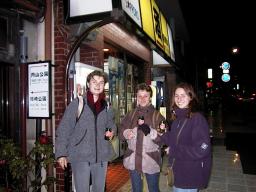
|
We weren't ready for sleeping yet but walked around chatting and
sometimes escaping cold to the numerous 24-hour stores. At this one we
bought some plum wine and later Slavka and Lubi came out from another
with a bottle of whisky...
|
|
(...but eventually didn't drink much and got back to the hostel
before midnight.)
next page >>
<< To the Japan index
|
Copyright Arto Teräs
<ajt@iki.fi> 2002.
Redistribution of this document as a whole or any of the pictures
individually is permitted in any medium provided this copyright
notice is preserved.
Last update 20.12.2002.
|


